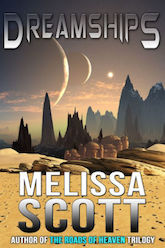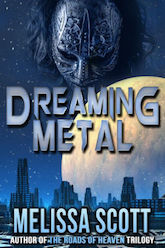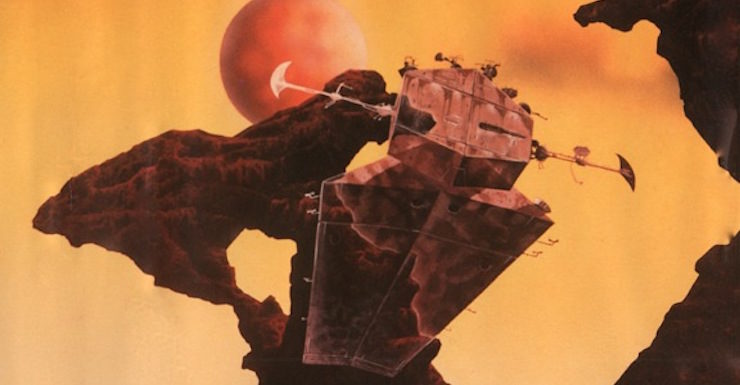This week’s column is likely to be my last to focus on Melissa Scott’s work, at least for a little while. I haven’t yet got my hands on A Choice of Destinies, Night Sky Mine, Burning Bright, or The Jazz, and there’s a whole rake of co-written novels as well. We may be revisiting Scott soon enough, but for now, this is it.
I’m going to look at take two books together this time. Dreamships, originally published in 1992 by Tor Books, and Dreaming Metal, originally published in 1997, also by Tor Books. These novels are closely linked: Dreaming Metal takes place in the same setting as Dreamships, an underground city home to the majority of the inhabitants of the planet Persephone, some five years after Dreamships‘ events, includes several of the same characters, and its arc concerns itself directly with the fallout of Dreamships’ climax and conclusion.
Buy the Book


Dreamships
Like many of Scott’s other novels, these two works are very much concerned with social disruption, with the rights of people on the margins, and with the difficulties of navigating social change and competing oppressions. That’s background worldbuilding for Dreamships and Dreaming Metal: Persephone is a world divided between “coolies” who have limited rights, “yanquis” who have more, relatively prosperous “midworlders,” and rich “underworlders” who live at the lowest, wealthiest levels of Persephone’s underground city. But the viewpoint character of Dreamships, pilot Reverdy Jian, and the viewpoint characters of Dreaming Metal—Jian, entertainer/artist Celinde Fortune, and performance artist/musician Fanning Jones—are all just trying to live their lives, and within the limits of the possible, do the right thing: none of them set out to change the world.
In Dreamships, Reverdy Jian, her colleague Imre Vaughn, and Vaughn’s partner Red, are hired to pilot a ship and test-drive a new construct that facilitates the artificial reality that allows pilots to interpret and thus navigate superluminary space. The construct, Manfred, seems much more complex than the usual run of things, and Jian and Vaughn begin to suspect Manfred actually represents AI. A series of complications leads to Jian, Vaughn, and Red being caught up in the middle of a movement by AI-rights advocate organisation Dreampeace to use Manfred as a case for establishing AI-rights—but complications include serious threats to Jian’s life.
Dreamships is slow to get started, atmospheric in its worldbuilding and full of compelling characters—and it’s even more complicated than this small précis would make you think. I enjoyed it a lot, but I enjoyed Dreaming Metal even more.
Buy the Book


Dreaming Metal
Dreaming Metal isn’t at all slow to get started. It revolves around theatre and performance, the art of making people see something that isn’t there—and around music and performance, the art of making people feel for something that could be there but isn’t, quite, tangible. This adds a poignancy to one of the problems that the main characters face: is AI real, or are they seeing more than is actually there? And if AI’s real, what are their responsibilities to it?
All this against a backdrop of civil disturbance, as activists for coolie rights resort to violent protest—violent protest that comes home to the theatre where two of the three main characters work.
It’s fast-paced, fascinating, and deeply compelling. I really liked it. I seriously recommend it.
And, looking back on Dreamships and Dreaming Metal, I realise that Scott has shown us a world where every single named character who’s shown as being attracted to other people is queer. Thoughtlessly, casually queer: it’s kind of fascinating to me, as a vision of the kind of science fiction I didn’t really know existed until a few years ago. It’s been said I’m a bit slow on the uptake sometimes, but honestly, I feel cheated that I wasn’t reading these books in my late teens. On the other hand, I’m old enough to appreciate them on several levels now—but still.
Cheated.
So, basically, if you haven’t been reading Melissa Scott’s work all along, I feel you’ve been missing out. And if you have—well, why the hell didn’t you tell me what I was missing?!
Liz Bourke is a cranky queer person who reads books. She holds a Ph.D in Classics from Trinity College, Dublin. Her first book, Sleeping With Monsters, a collection of reviews and criticism, was published in 2017 by Aqueduct Press. It was a finalist for the 2018 Locus Awards and is nominated for a Hugo Award in Best Related Work. Find her at her blog, where she’s been known to talk about even more books thanks to her Patreon supporters. Or find her at her Twitter. She supports the work of the Irish Refugee Council and the Abortion Rights Campaign.










